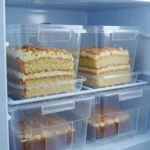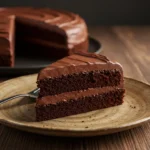There’s nothing quite like biting into a warm, chewy chocolate chip cookie soft in the center, crisp at the edges, and packed with rich chocolate flavor. If you’ve been searching for that bakery-style texture in your homemade cookies, you’re not alone. Chewy chocolate chip cookies are a classic favorite across the U.S., and achieving that perfect chew is all about understanding your ingredients and baking method.
In this comprehensive guide, we’ll walk you through a tried-and-true recipe for chewy chocolate chip cookies and dig into the science behind what makes them irresistibly soft. We’ll cover popular questions like why milk or cornstarch is added, whether brown sugar really makes a difference, and even the role of baking soda vs. baking powder. This isn’t just a recipe it’s your full roadmap to cookie bliss.
Table of Contents
Table of Contents
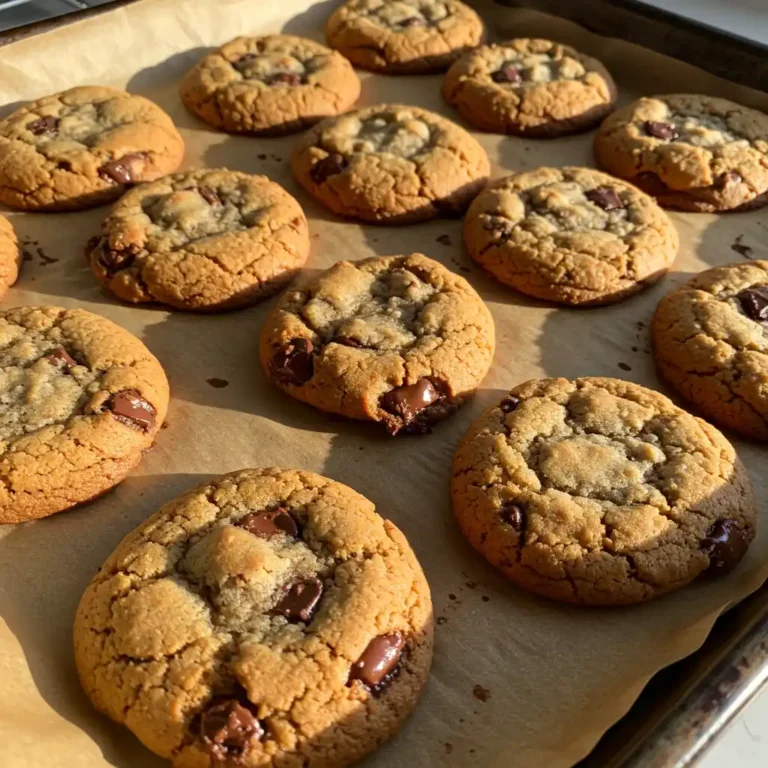
Chewy Chocolate Chip Cookies: 9 Expert Secrets for Irresistible Bakes
These chewy chocolate chip cookies are soft in the middle, slightly crisp on the edges, and bursting with gooey chocolate chips. Perfect for every cookie lover craving a bakery-style treat at home.
- Total Time: 27 minutes
- Yield: 24 cookies 1x
Ingredients
2 1/4 cups all-purpose flour
1 tsp baking soda
2 tsp cornstarch
1/2 tsp salt
3/4 cup unsalted butter, melted
3/4 cup brown sugar (packed)
1/2 cup granulated sugar
2 large eggs
2 tsp pure vanilla extract
2 tbsp whole milk
2 cups semi-sweet chocolate chips
Instructions
- In a medium bowl, whisk together flour, baking soda, cornstarch, and salt. Set aside.
- In a large bowl, mix melted butter, brown sugar, and granulated sugar until smooth.
- Add eggs one at a time, then stir in vanilla extract and milk.
- Gradually fold dry ingredients into wet ingredients using a spatula.
- Stir in chocolate chips until evenly distributed.
- Cover dough and refrigerate for 30 minutes (optional but recommended).
- Preheat oven to 350°F (175°C) and line baking sheets with parchment paper.
- Scoop dough into 1.5-inch balls and place 2 inches apart on baking sheet.
- Bake for 10–12 minutes or until edges are golden and centers look set.
- Let cookies cool on the pan for 5 minutes before transferring to a wire rack.
Notes
- For extra flavor, use dark brown sugar instead of light.
- Don’t skip chilling the dough it helps develop flavor and texture.
- Add a pinch of sea salt on top before baking for a gourmet touch.
- Prep Time: 15 minutes
- Cook Time: 12 minutes
- Category: Dessert
- Method: Baking
- Cuisine: American
Nutrition
- Serving Size: 1 cookie
- Calories: 210
- Sugar: 18g
- Sodium: 120mg
- Fat: 10g
- Saturated Fat: 6g
- Unsaturated Fat: 3g
- Trans Fat: 0g
- Carbohydrates: 28g
- Fiber: 1g
- Protein: 2g
- Cholesterol: 25mg
The Ultimate Chewy Chocolate Chip Cookies Recipe
Essential Ingredients for Chewiness
To create the best chewy chocolate chip cookies, it all starts with the right blend of ingredients. Here’s what you’ll need:
| Ingredient | Quantity | Why It Matters |
|---|---|---|
| Unsalted butter | 1 cup (2 sticks) | Adds moisture and richness |
| Brown sugar (packed) | 1 cup | Increases moisture and chewiness |
| Granulated sugar | ½ cup | Balances sweetness and helps with structure |
| Large eggs | 2 | Binds ingredients and enhances texture |
| Vanilla extract | 2 tsp | Adds deep flavor |
| All-purpose flour | 2½ cups | Structure of the cookie |
| Cornstarch | 2 tsp | Softens the dough and thickens |
| Baking soda | 1 tsp | Promotes spreading and chewiness |
| Salt | ½ tsp | Balances sweetness |
| Semisweet chocolate chips | 2 cups | Gooey chocolate in every bite |
Step-by-Step Instructions
1. Preheat the Oven
Set your oven to 350°F (175°C). Line baking sheets with parchment paper or silicone mats.
2. Cream Butter and Sugars
In a large bowl, beat 1 cup unsalted butter, 1 cup brown sugar, and ½ cup granulated sugar until light and fluffy. This step is essential for creating that classic chewy chocolate chip cookie texture.
3. Add Eggs and Vanilla
Beat in 2 large eggs, one at a time. Stir in 2 teaspoons vanilla extract. Mixing slowly helps avoid overworking the dough, which can make cookies tough.
4. Mix Dry Ingredients Separately
In another bowl, whisk together 2½ cups all-purpose flour, 2 teaspoons cornstarch, 1 teaspoon baking soda, and ½ teaspoon salt. Cornstarch is the hidden hero that gives chewy chocolate chip cookies their soft centers.
5. Combine Wet and Dry
Gradually mix the dry ingredients into the wet mixture. Be sure not to overmix. The dough will be thick and slightly sticky.
6. Fold in Chocolate Chips
Stir in 2 cups of semisweet chocolate chips. If you want extra chocolatey cookies, use a mix of regular and mini chips.
7. Chill the Dough
Cover and chill the dough for at least 30 minutes (or up to 24 hours). Chilling helps control spread and intensifies flavor key to chewy chocolate chip cookies.
8. Scoop and Bake
Scoop the dough into rounded tablespoons and place them 2 inches apart on the baking sheet. Bake for 10–12 minutes, or until the edges are lightly golden but the centers look just set.
9. Cool and Enjoy
Let cookies rest on the baking sheet for 5 minutes, then transfer to a wire rack to cool. For chewiest results, avoid overbaking!
Quick Tips for Chewy Perfection
- Always measure flour correctly too much will make cookies cakey.
- Don’t skip chilling the dough!
- Brown sugar is your chew-enhancing secret weapon.
The Science Behind Chewy Chocolate Chip Cookies
Why Are Some Cookies Chewy While Others Are Crunchy?
The chewy texture in chocolate chip cookies isn’t just luck it’s chemistry. The moisture content, sugar type, fat source, and even mixing method influence whether your cookies turn out soft or snappy.
Moisture retention is the magic word. The more moisture you can retain in your cookie dough (and prevent from baking out), the chewier the final texture. That’s why chewy chocolate chip cookies often call for more brown sugar, extra egg yolks, or a touch of cornstarch.
Cookies with less moisture or ones baked longer tend to be crispier.
How Sugar Affects Texture: Brown Sugar vs. White Sugar
So, does brown sugar make cookies chewy? Yes. 100% yes.
Brown sugar contains molasses, which is hygroscopic (it attracts and retains moisture). This moisture translates to softer, thicker, and chewier chocolate chip cookies. It also adds a subtle caramel-like depth of flavor.
| Sugar Type | Effect on Texture | Taste Impact |
|---|---|---|
| Brown Sugar | Makes cookies chewy & soft | Rich, deep sweetness |
| White Sugar | Promotes crispiness | Clean, sweet flavor |
| 50/50 Blend | Balanced chewy + crispy combo | Sweet with depth |
If you want that iconic chewy chocolate chip cookie, always prioritize brown sugar over white or at least use more of it.
The Role of Cornstarch in Cookie Dough
Cornstarch isn’t just for sauces. In baking, it acts as a tenderizer. When added to cookie dough, cornstarch:
- Softens the final texture
- Reduces spreading in the oven
- Keeps cookies thick and chewy
This is why so many chewy chocolate chip cookie recipes include 1 to 2 teaspoons of cornstarch it’s a little secret that yields a big difference.
Looking for inspiration? Try our cornstarch-rich dessert bakes for other soft treats.
Milk in Cookies: Does It Help with Chewiness?
Yes, adding a splash of milk (usually 1–2 tablespoons) can help make cookies more chewy and tender. Milk adds hydration and fat, which can:
- Boost moisture levels
- Enhance spread
- Prevent a dry crumb
But too much milk can make dough sticky or cakey so use it sparingly if you’re adjusting a classic chewy chocolate chip cookie recipe.
Eggs: The Secret Ingredient to Softness
Eggs do more than bind dough they determine texture. So what happens if you add an extra egg to chocolate chip cookies?
Here’s the breakdown:
- 1 egg: Standard structure
- 2 eggs: Moist, soft cookies
- Extra yolk: Chewy, fudgy results
- Extra white: Crispier cookies
If your goal is chewy chocolate chip cookies, try adding an extra egg yolk. It boosts richness without making the dough too wet.
Butter: Cold, Softened, or Melted?
The form of butter you use changes everything.
| Butter State | Cookie Texture | Pros & Cons |
|---|---|---|
| Melted Butter | Denser, chewier cookies | Easy to mix, but cookies spread more |
| Softened Butter | Classic bakery-style cookies | Fluffy yet chewy |
| Cold Butter | Less common, firmer texture | Less spread, thicker cookies |
Melted butter = ultra chewy chocolate chip cookies. But chilling the dough becomes even more important to prevent overspreading.
Don’t miss our cookie texture hacks with butter for pro-level baking insight.
Baking Soda vs. Baking Powder: What’s Best for Chewy Cookies?
This is a common debate. The answer?
Use baking soda for chewy chocolate chip cookies.
Why?
- Baking soda reacts with acid (like brown sugar or molasses), creating carbon dioxide and giving cookies their spread and chewy structure.
- Baking powder, on the other hand, creates cakier cookies due to its dual-action leavening.
Stick with 1 teaspoon baking soda unless you’re intentionally going for fluffier, cake-like cookies.
Common Mistakes That Ruin Chewy Chocolate Chip Cookies
1. Overmixing the Dough
It might feel satisfying to keep stirring that dough, but overmixing is the enemy of chewy chocolate chip cookies. When you mix too much, the flour develops gluten. While a little gluten gives structure, too much makes cookies tough and bready not soft and chewy.
Fix:
Once the flour is just incorporated, stop. Fold in the chocolate chips gently. Your dough should look rustic, not overworked.
2. Using Too Little Fat
Fat especially butter is a key player in achieving that melt-in-your-mouth chewiness. Some bakers try to cut back on butter or substitute it with oil or margarine, but that can make the cookies dry or cakey.
Fix:
Stick with real butter (preferably unsalted). If you’re aiming for ultra chewy chocolate chip cookies, melted butter is the go-to just remember to chill the dough afterward to control spreading.
3. Skipping the Chill Time
You’re excited. You want cookies now. But skipping chill time means sacrificing texture.
Why it matters:
- Chilling solidifies the fat, preventing overspreading.
- It allows flour to hydrate, enhancing flavor and chewiness.
- Cold dough leads to thicker, chewier chocolate chip cookies.
Fix:
Refrigerate the dough for at least 1 hour. For best results, chill overnight. Yes, it’s hard to wait, but the payoff is real.
Discover great ideas like overnight cookie dough tricks to boost flavor and texture.
4. Incorrect Oven Temperature
Most recipes say to bake at 350°F, but here’s the thing: ovens lie.
If your oven runs hot, your cookies may bake too quickly, browning the edges and leaving dry centers. If it’s too cool, the cookies spread too much and bake flat.
Fix:
Use an oven thermometer to ensure accuracy. Stick with 350°F for chewy chocolate chip cookies and bake on the center rack.
5. Baking Too Long
This is one of the most common issues overbaking. Cookies should be slightly underbaked when they come out. They’ll continue to bake on the hot pan from residual heat.
What happens when you bake too long?
- Cookies get dry
- Edges become hard
- Centers lose moisture = no chewiness
Fix:
Bake for 9–11 minutes, or until edges are lightly golden but centers look soft. Don’t wait for a firm top it’ll firm up as it cools.
6. Wrong Sugar Ratios
Using the wrong balance of brown and white sugar alters everything. Too much white sugar, and you get crunchy cookies. Not enough brown sugar? You lose the molasses moisture that gives chewy chocolate chip cookies their signature bite.
Fix:
Use at least a 2:1 ratio of brown sugar to white sugar. Or go all in with 100% brown sugar for maximum chew.
| Sugar Ratio | Resulting Texture |
|---|---|
| 1:1 (brown:white) | Balanced (chewy + crisp) |
| 2:1 (brown:white) | Chewy and rich |
| All brown sugar | Ultra chewy and moist |
| All white sugar | Thin and crispy |
7. Forgetting the Cornstarch
Many skip this thinking it’s optional. But if you’re craving those bakery-style chewy chocolate chip cookies, cornstarch is your silent hero. It makes the cookies tender and thick without compromising structure.
Fix:
Add 1–2 teaspoons of cornstarch per batch. It subtly improves the texture.
Check out our soft cookie secrets with cornstarch for more chewy upgrades.
8. Not Measuring Flour Properly
Using too much flour results in dry, crumbly cookies nothing chewy about that. The mistake? Scooping flour directly from the bag or container packs it down, leading to more than needed.
Fix:
Always spoon and level your flour. Or better yet, use a kitchen scale:
- 1 cup of flour = 120 grams
It’s a small change, but it can rescue your chewy chocolate chip cookie game.
Step-by-Step Recipe for Chewy Chocolate Chip Cookies
1. Ingredients You’ll Need
If you’re aiming for chewy chocolate chip cookies that are soft in the center, golden at the edges, and absolutely addicting, start with high-quality ingredients. Here’s your essential lineup:
| Ingredient | Amount | Notes |
|---|---|---|
| Unsalted Butter | 1 cup (2 sticks) | Melted and slightly cooled |
| Brown Sugar | 1 cup | Light or dark adds deep moisture |
| Granulated Sugar | ½ cup | Just enough for crisp edges |
| Large Eggs | 2 | Room temperature |
| Vanilla Extract | 2 tsp | Use real extract for best flavor |
| All-Purpose Flour | 2 ¼ cups | Measured correctly (spooned and leveled) |
| Baking Soda | 1 tsp | Helps rise and spread |
| Cornstarch | 2 tsp | For extra soft, chewy texture |
| Salt | ½ tsp | Balances sweetness |
| Chocolate Chips | 2 cups | Semi-sweet or a mix of chunks and chips |
Learn more about cookie baking substitutions and swaps for dietary preferences or ingredient shortages.
2. Tools You’ll Need
- Large mixing bowl
- Whisk or hand mixer
- Rubber spatula
- Measuring cups and spoons
- Baking sheet
- Parchment paper
- Cookie scoop (optional but helpful)
3. Mixing the Wet Ingredients
Start with the melted butter this is the secret to the ultimate chewy chocolate chip cookies.
- In a large bowl, whisk together the melted butter, brown sugar, and white sugar until smooth and glossy.
- Add in the eggs, one at a time, mixing until fully combined.
- Stir in the vanilla extract.
Using melted butter instead of softened butter enhances chewiness. Just be sure it’s not hot lukewarm is ideal.
4. Combining the Dry Ingredients
In a separate bowl, whisk together:
- Flour
- Baking soda
- Cornstarch
- Salt
Gradually add this mixture to your wet ingredients, mixing gently with a spatula. Don’t overmix stop once it’s just combined. Your dough should be soft and slightly sticky.
Looking for inspiration? Try our guide to flour types and textures.
5. Fold in the Chocolate Chips
Add your chocolate chips or chunks last. Fold them in evenly so every bite is loaded with melty goodness. You can also add some chopped chocolate or sea salt flakes on top for a bakery-style finish.
6. Chill the Dough
Cover the bowl and refrigerate the dough for at least 1 hour, or overnight if possible. This helps:
- Thicken the dough
- Enhance the cookie’s flavor
- Prevent excessive spreading during baking
This single step is a game-changer for chewy chocolate chip cookies.
7. Preheat and Portion
Preheat your oven to 350°F (175°C). Line a baking sheet with parchment paper.
Using a cookie scoop or tablespoon, scoop balls of dough about 2 tablespoons in size and place them 2 inches apart on the baking sheet.
Don’t miss our guide to perfect cookie shaping for uniform, beautiful cookies.
8. Bake to Perfection
Bake for 9–11 minutes, until the edges are lightly golden and the centers are still soft. Don’t wait for the tops to look fully cooked they’ll finish baking on the sheet after you take them out.
Let cookies rest on the baking sheet for 5 minutes before transferring to a wire rack to cool completely.
9. Enjoy Your Chewy Chocolate Chip Cookies!
Once cooled, take a bite. You’ll taste:
- Crisp edges
- Gooey, melty chocolate centers
- Rich, buttery depth from brown sugar
- Soft, pillowy chew in every bite
These are the kind of chewy chocolate chip cookies that disappear faster than you can make them. Make a double batch you won’t regret it!
Healthy Ingredient Swaps for Chewy Chocolate Chip Cookies
1. Using Whole Wheat Flour Instead of All-Purpose
Switching to whole wheat flour is an excellent way to add fiber and nutrients without sacrificing chewiness. Whole wheat has more protein, which can actually help your cookies stay thick and chewy, though it may add a slight nuttiness to the flavor.
How to swap:
Use 50% whole wheat flour and 50% all-purpose flour to start. This balance keeps the chewiness intact while making the cookie healthier.
2. Replacing Butter with Coconut Oil
Coconut oil is a popular alternative to butter for those seeking dairy-free or vegan options. It adds a subtle tropical flavor and keeps cookies moist.
Tip:
Use solid coconut oil, not melted, to replicate the creaming effect of butter. This helps the dough hold together and keeps the cookies chewy.
3. Reducing Sugar with Natural Sweeteners
Brown sugar contributes a lot to the chewiness and flavor, but reducing refined sugars can benefit health-conscious bakers.
Alternatives include:
- Maple syrup
- Honey
- Coconut sugar
Note: When using liquid sweeteners like maple syrup or honey, reduce other liquids slightly and expect a softer cookie.
4. Adding Flaxseed as an Egg Substitute
For vegan or egg-free cookies, ground flaxseed mixed with water works great as an egg replacer. This swap keeps the dough moist and chewy.
How to make flax egg:
Mix 1 tablespoon ground flaxseed with 3 tablespoons water, let sit for 5 minutes until gelled.
5. Using Dark Chocolate Instead of Milk Chocolate
Dark chocolate not only offers more antioxidants but also less sugar. It pairs perfectly with chewy chocolate chip cookies to give a rich, slightly bitter contrast.
Try:
Chopping up a 70% dark chocolate bar into chunks instead of traditional chips.
6. Adding Oats or Nuts for Extra Nutrition
Adding rolled oats or chopped nuts like walnuts or almonds boosts fiber, protein, and healthy fats. They also add a satisfying crunch to your chewy chocolate chip cookies.
Tip:
Add about ½ cup of oats or nuts to your standard dough without changing other ingredients much.
7. Using Applesauce to Cut Fat
If you want to reduce butter without losing moisture, try substituting half the butter with unsweetened applesauce. This keeps cookies soft, though chewiness might be slightly reduced.
8. Using Greek Yogurt for Protein and Moisture
Adding a tablespoon or two of Greek yogurt adds protein and moisture. It keeps cookies tender but chewy.
Discover great ideas like healthy cookie recipes to explore more guilt-free treats without sacrificing flavor.
Expert Tips and Tricks for Perfect Chewy Chocolate Chip Cookies
1. Why Chilling Dough Makes a Difference
One of the most effective tips for achieving chewy chocolate chip cookies is refrigerating the dough before baking. Chilling allows the fats to solidify, which slows down cookie spreading in the oven, resulting in thicker, chewier cookies. It also gives the flour time to fully hydrate, improving texture and flavor.
For best results, chill your dough for at least 1 hour overnight chilling is even better.
2. Use Brown Sugar for That Signature Chew
Brown sugar contains molasses, which attracts moisture and keeps cookies soft and chewy for longer. Using a higher ratio of brown sugar to granulated sugar is key to achieving the right chew.
Try using 1 cup brown sugar to ½ cup granulated sugar for perfectly chewy chocolate chip cookies.
3. Incorporate Cornstarch for Tenderness
Adding cornstarch to your dry ingredients is a secret many bakers swear by. It helps tenderize the cookie dough by preventing too much gluten formation, leading to soft, chewy cookies that aren’t cakey.
A typical amount is 1 to 2 teaspoons of cornstarch per batch.
4. Don’t Overbake Your Cookies
Chewy chocolate chip cookies need a gentle touch in the oven. Baking too long dries out the cookies, turning them crunchy instead of chewy. Pull your cookies out when the edges are golden but the centers still look slightly underdone.
Let them cool on the baking sheet to finish baking with residual heat.
5. Use Melted Butter for Chewiness
Melted butter creates a denser dough that results in chewier cookies. Unlike softened butter, which aerates the dough and produces fluffier cookies, melted butter yields that rich, tender chewiness everyone loves.
Make sure your melted butter is cool but still liquid before mixing.
6. Adjust Baking Soda vs. Baking Powder
For chewy chocolate chip cookies, baking soda is generally preferred because it promotes spreading and browning, which gives that crisp edge and chewy middle.
Baking powder tends to make cookies puffier and cakier, so stick with baking soda if chewiness is your goal.
7. Use Room Temperature Eggs
Room temperature eggs mix more easily into the dough, helping to create a uniform texture. Cold eggs can cause the dough to seize up and bake unevenly.
8. Experiment with Dough Portion Sizes
Using a cookie scoop to make uniform dough balls helps ensure consistent baking. Larger dough balls tend to yield thicker, chewier cookies because the inside stays soft longer.
Check out our complete baking tips for cookies to master the art of chewy chocolate chip cookies.
Common Mistakes to Avoid When Making Chewy Chocolate Chip Cookies
1. Using Too Much Flour
One common mistake that ruins chewy chocolate chip cookies is adding too much flour. Over-flouring thickens the dough excessively, resulting in dry and crumbly cookies rather than soft and chewy.
Always measure flour correctly preferably by weighing it or spooning it lightly into the measuring cup and leveling it off. Avoid scooping directly with the cup.
2. Skipping the Cornstarch
Cornstarch might seem like an unusual addition, but omitting it can make cookies tough or cakey instead of chewy. This ingredient helps tenderize the dough by reducing gluten formation.
Make sure to include 1-2 teaspoons of cornstarch for that ideal chewy texture.
3. Overbaking Your Cookies
Baking chocolate chip cookies too long is a surefire way to lose chewiness. Once the edges start browning, cookies should be removed, even if the centers look slightly underbaked they’ll continue to firm up while cooling.
4. Using the Wrong Sugar Ratio
Using only granulated sugar results in crisp, crunchy cookies, while an excess of brown sugar creates overly soft cookies that may spread too much. The balance is key.
Aim for a mix of brown and granulated sugar, with a heavier emphasis on brown sugar to enhance chewiness.
5. Not Chilling the Dough
Skipping the dough chilling step can lead to flat, hard cookies. Chilling solidifies the fat, allowing cookies to hold their shape and stay chewy.
Refrigerate dough for at least an hour or overnight for the best results.
6. Using Melted Butter Without Adjusting
Melted butter contributes to chewiness but can cause dough to spread excessively if not balanced with proper chilling or flour ratios. If using melted butter, refrigerate the dough to control spreading.
7. Ignoring Oven Temperature
Baking at the wrong temperature can affect cookie texture. Too hot and the cookies burn or crisp too fast; too low and they dry out.
Preheat your oven to 350°F (175°C) for chewy chocolate chip cookies, baking for 8–12 minutes depending on size.
Learn more about common cookie baking mistakes and how to fix them for perfect chewy chocolate chip cookies every time.
Storage Tips to Keep Your Chewy Chocolate Chip Cookies Fresh Longer
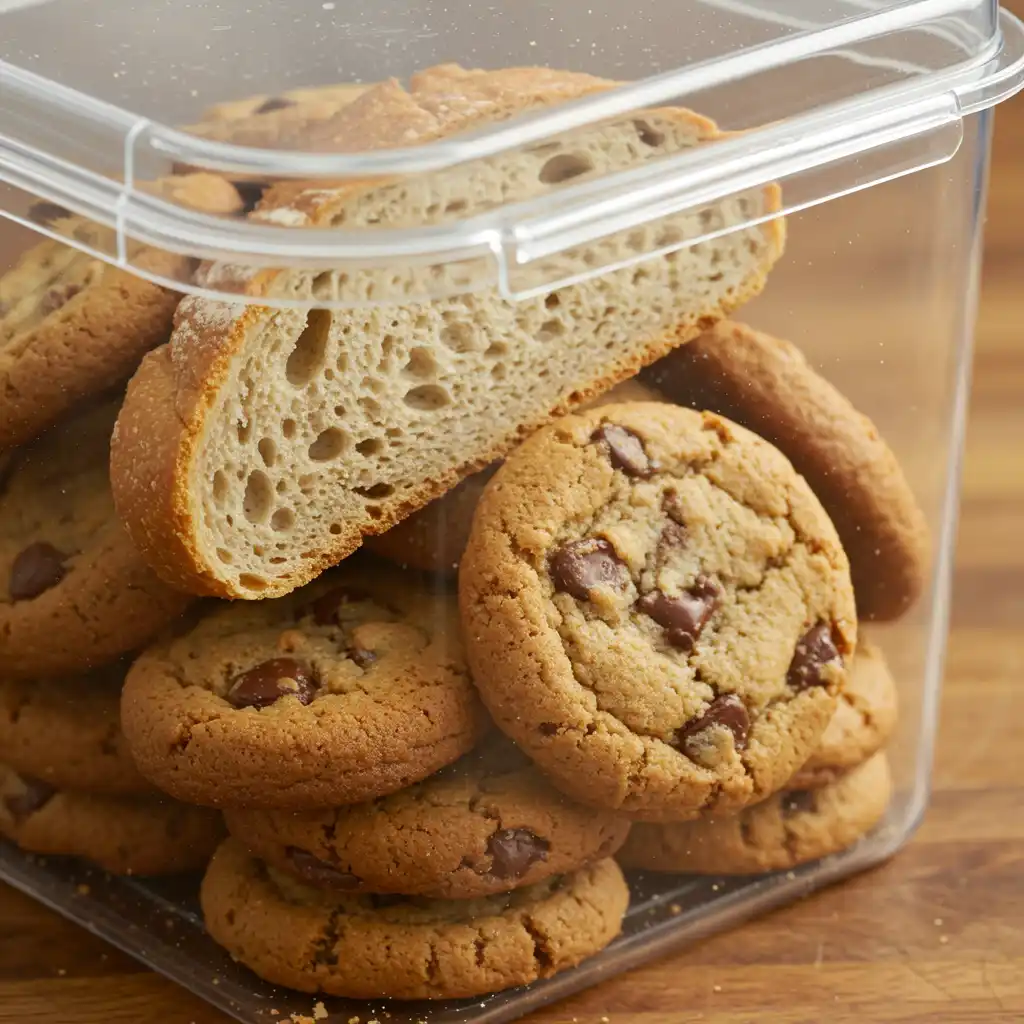
1. Store Cookies in an Airtight Container
The key to maintaining the perfect chewy texture is to keep moisture in. Store your cookies in an airtight container at room temperature. This helps prevent them from drying out or becoming stale.
Use containers with a tight-sealing lid or zip-top bags for the best results.
2. Add a Slice of Bread to Retain Moisture
A popular trick for chewy chocolate chip cookies is placing a slice of bread inside the cookie container. The bread releases moisture that the cookies absorb, keeping them soft longer.
Replace the bread slice every couple of days for maximum freshness.
3. Refrigerate for Longer Storage
If you want to keep your cookies fresh for more than a week, refrigeration is a good option. Just be sure to keep the cookies sealed tightly in an airtight container to prevent them from absorbing fridge odors or drying out.
Before serving, let refrigerated cookies come to room temperature for the best chewy texture.
4. Freeze Cookie Dough for Fresh Baking
For freshly baked chewy chocolate chip cookies anytime, freeze the cookie dough in balls. Wrap each dough ball in plastic wrap and store them in a freezer-safe bag.
When ready to bake, thaw dough balls in the fridge overnight or bake from frozen, adding a minute or two to the baking time.
5. Freeze Baked Cookies Properly
You can also freeze baked cookies. Lay them out on a baking sheet to freeze individually, then transfer to a freezer-safe container or bag. Freeze for up to 3 months.
Thaw frozen cookies at room temperature or warm them slightly in the oven for a fresh-baked feel.
Don’t miss our ultimate cookie storage guide to keep your chewy chocolate chip cookies tasting fresh and delicious.
FAQs and Conclusion on Chewy Chocolate Chip Cookies
FAQs About Chewy Chocolate Chip Cookies
1. Why add milk to chocolate chip cookies?
Adding a small amount of milk adds moisture to the dough, which can help make cookies softer and chewier. It also contributes to the browning process, enhancing flavor and color.
2. Why add cornstarch to chocolate chip cookies?
Cornstarch helps tenderize the cookies by limiting gluten formation. This makes cookies softer and chewier, preventing them from turning cakey or tough.
3. Does brown sugar make cookies chewy?
Yes, brown sugar contains molasses that attracts moisture and keeps cookies soft and chewy for longer periods compared to white sugar.
4. Is it better to use baking powder or baking soda in cookies?
Baking soda is generally preferred for chewy chocolate chip cookies because it promotes spreading and browning. Baking powder tends to create puffier, cakier cookies.
5. What happens if you add an extra egg to chocolate chip cookies?
Adding an extra egg increases moisture and fat, making cookies softer and chewier, but it can also cause them to spread more and lose structure.
6. How long do you bake cookies at 350 degrees?
Bake chewy chocolate chip cookies at 350°F for 8 to 12 minutes. Remove when edges are golden but centers still look slightly underbaked.
7. Should you refrigerate cookie dough before baking?
Yes, refrigerating cookie dough for at least 1 hour helps solidify fats, reducing spreading and enhancing chewiness.
8. How many sticks of butter to make one cup?
One cup of butter equals 2 sticks (each stick is ½ cup).
9. What happens if you use melted butter in chocolate chip cookies?
Melted butter creates a denser dough, which results in chewier cookies. However, it can cause cookies to spread more, so chilling the dough is recommended.
Conclusion
Mastering the art of chewy chocolate chip cookies is all about balancing ingredients, understanding baking techniques, and avoiding common mistakes. From choosing the right sugar blend and incorporating cornstarch, to chilling dough and carefully timing your bake, each step influences the final texture and flavor. With these tips, tricks, and expert advice, you can consistently bake cookies that are perfectly chewy, delightfully soft, and packed with rich chocolate flavor. Whether baking for family or special occasions, chewy chocolate chip cookies remain a beloved treat worth perfecting.
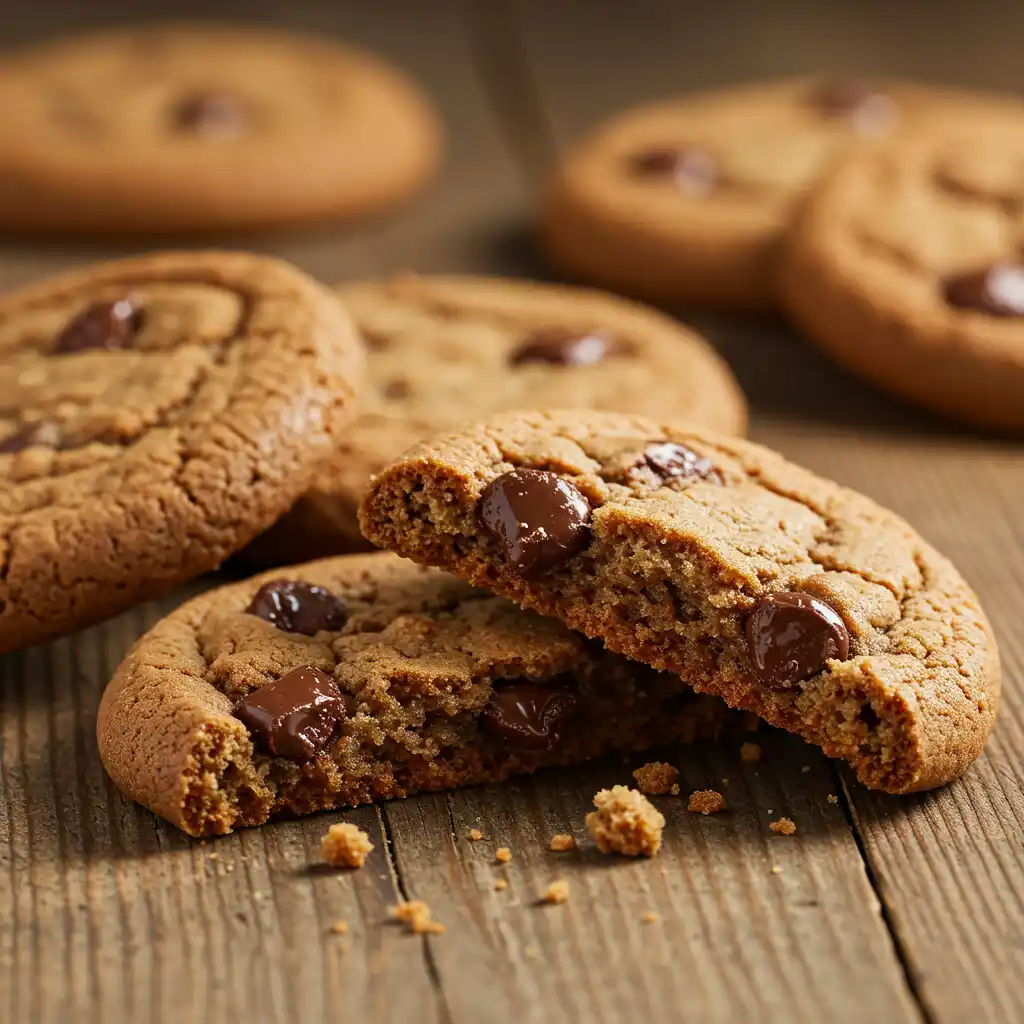
For more recipes and baking advice, check out our full dessert collection.
Did You Try Our Recipe?
There are no reviews yet. Be the first one to write one.



